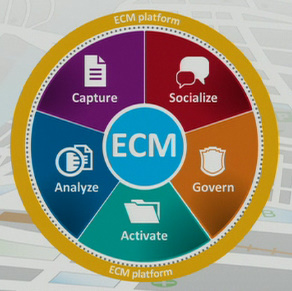Content at rest = cost
Content in motion = value
That was the message that kicked off the ECM keynote, then Kevin Painter took the stage to introduce the winners of the four ECM customer innovation awards – Novartis, Tejon Ranch, US Nuclear Regulatory Commission and Wells Fargo – before turning things over to Doug Hunt.
IBM defines unstructured data, or content, as pretty much everything that doesn’t fit in a database table. Traditionally, this type of information is seen as inaccessible, cumbersome, expensive, unmanageable and risky by business, IT, records managers and legal. However, with the right management of that content, including putting it into motion to augment systems of record, it can become accessible and relevant, providing a competitive advantage.
 We heard from Wells Fargo about their ECM implementation, where they are moving from having scanned documents as merely an archival practice to having those documents be an active part of the business transactions. [This sounds just like moving from post-processing scanning to pre-processing scanning and workflow, which we’ve been doing for 30+ years, but maybe it’s more complex than that.] For them, ECM is a fundamental part of their mortgage processing architecture and business transaction enabling, supporting multiple lines of business and processes. This, I think, is meant to represent the “Capture” slice of the pie.
We heard from Wells Fargo about their ECM implementation, where they are moving from having scanned documents as merely an archival practice to having those documents be an active part of the business transactions. [This sounds just like moving from post-processing scanning to pre-processing scanning and workflow, which we’ve been doing for 30+ years, but maybe it’s more complex than that.] For them, ECM is a fundamental part of their mortgage processing architecture and business transaction enabling, supporting multiple lines of business and processes. This, I think, is meant to represent the “Capture” slice of the pie.
Novartis was on stage next to talk about their records management (the “Govern” slice), particularly around retention management of their records to reduce legal risk across their multi-national organization.
Next, Hunt addressed “Analyze” with content analytics, joined by someone from Seton Healthcare to discuss how they’re using Watson analytics to proactively identify certain high-risk patients with congestive heart failure to allow early treatment that can reduce the rate of hospital readmissions. With 80% of their information being unstructured, they need something beyond standard analytics to address this.
Case management was highlighted as addressing the “Activate” slice, and Hunt was joined by someone from SEB, a Nordic bank, to discuss how they are using IBM Case Manager as an exception handling platform (i.e., for those processes that kick out of the standard straight-through process), replacing their existing workflow engine.
Hunt did briefly address the “Socialize” slice, but he was so clued out about anything to do with social content, it was a bit embarrassing. Seriously, I don’t want to hear the executive in charge of IBM’s ECM strategy talk about social as something that his wife and kids do, but he doesn’t.
He finished up talking about the strength of the IBM ECM industry accelerators and business partners, both of which help to get systems up and running at their customers’ sites as quickly as possible.
